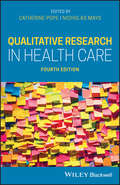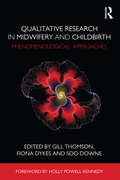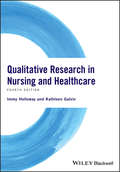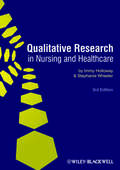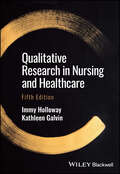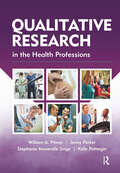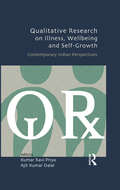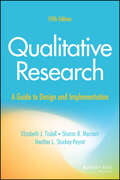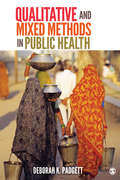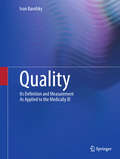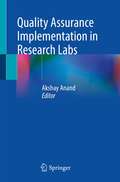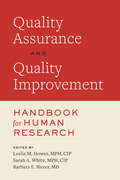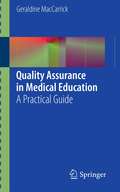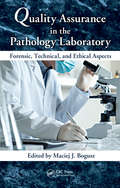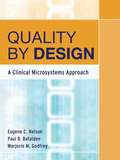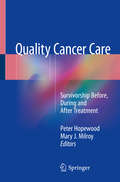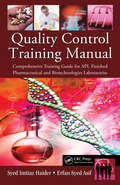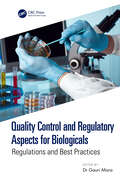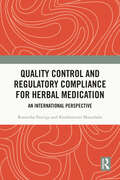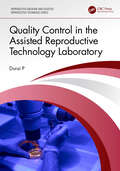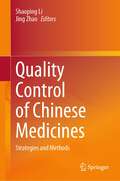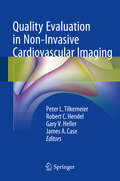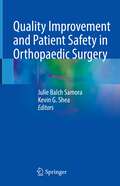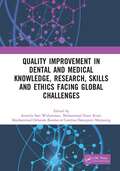- Table View
- List View
Qualitative Research in Health Care
by Catherine Pope Nicholas MaysProvides the essential information that health care researchers and health professionals need to understand the basics of qualitative research Now in its fourth edition, this concise, accessible, and authoritative introduction to conducting and interpreting qualitative research in the health care field has been fully revised and updated. Continuing to introduce the core qualitative methods for data collection and analysis, this new edition also features chapters covering newer methods which are becoming more widely used in the health research field; examining the role of theory, the analysis of virtual and digital data, and advances in participatory approaches to research. Qualitative Research in Health Care, 4th Edition looks at the interface between qualitative and quantitative research in primary mixed method studies, case study research, and secondary analysis and evidence synthesis. The book further offers chapters covering: different research designs, ethical issues in qualitative research; interview, focus group and observational methods; and documentary and conversation analysis. A succinct, and practical guide quickly conveying the essentials of qualitative research Updated with chapters on new and increasingly used methods of data collection including digital and web research Features new examples and up-to-date references and further reading The fourth edition of Qualitative Research in Health Care is relevant to health care professionals, researchers and students in health and related disciplines.
Qualitative Research in Midwifery and Childbirth: Phenomenological Approaches
by Soo Downe Gill Thomson Fiona DykesQualitative research, particularly phenomenology, is increasingly popular as a method for midwifery and health-related research. These approaches enable rich and detailed explanations to be uncovered and bring experience to life. Important recommendations and practice- based implications may then be raised and debated for future use. This book brings together a range of phenomenological methods and insights into one accessible text. Illustrated with plenty of examples of successful phenomenological research, Qualitative Research in Midwifery and Childbirth keeps the focus applied to midwifery and childbirth and makes clear the links to practice throughout. The book introduces three key phenomenological approaches – descriptive, interpretive and the life world – and includes a comparative chapter which discusses the differences between these varied perspectives and methods. Each chapter focuses on how these approaches are used within midwifery research. The remaining chapters present a number of different research projects. These demonstrate how different phenomenological approaches have been used to explore and uncover experiences of childbirth and maternity as well as offering important insights into how women experience different facets of the birth experience during the antenatal, intra-partum and postnatal period. Designed for researchers and students undertaking research projects on midwifery and childbirth, this text includes contributions from a range of international and highly regarded phenomenological authors and researchers.
Qualitative Research in Nursing and Healthcare
by Immy Holloway Kathleen GalvinQualitative Research in Nursing and Healthcare is an invaluable resource for those who carry out qualitative research in the healthcare arena. It is intended to assist: Professionals and academics in the healthcare field who undertake or teach research in clinical or educational settings; Postgraduates who are undertaking qualitative research and want to revise qualitative research approaches and procedures before going on to more specialist texts; and Undergraduates in their last year who wish to learn about qualitative perspectives or carry out a project using these approaches. Fully updated from the earlier editions by Holloway and Wheeler, it reflects recent developments in nursing research. This new edition provides clear explanations of abstract ideas in qualitative research as well as practical procedures. Structured into four sections, the book looks at the initial stages, methods of data collection, qualitative approaches and analysis of collected data. It also contains a chapter on writing up and publishing qualitative research. With applied and practical examples throughout, Qualitative Research in Nursing and Healthcare is essential reading for those who are looking for a comprehensive introduction to qualitative research.
Qualitative Research in Nursing and Healthcare
by Immy Holloway Stephanie Wheeler'…a wonderfully easy-to-follow text which manages to combine practical procedures with clear explanations of the underlying theoretical concepts.' Nursing Standard (from review of first edition) The third edition of this successful book incorporates recent developments in nursing research, with updates to every chapter. Abstract ideas in qualitative research are clearly explained and more complex theories are included. Structured into four clear sections, the book looks at initial stages, methods of data collection, qualitative approaches and analysis of collected data. Brand new chapter on Mixed Methods Research Considers a variety of approaches from Ethnography to Action Research Allows the reader to dip in and out depending on their choice of approach Detailed reference lists provide guidance for further reading Links research with real nursing practice through relevant examples throughout Professor Immy Holloway has been at Bournemouth University since its inception and works in the School of Health and Social Care. Though now retired from full-time work, she still takes an active in teaching and PhD supervision. She wrote, edited and co-wrote several books in the field of qualitative research which have been translated into several languages and published articles in peer reviewed journals. Her latest book is A-Z of Qualitative Research in Healthcare. (2008) Oxford: Blackwell. Stephanie Wheeler, an academic with a nursing and health visiting background, is a specialist in healthcare ethics and was for many years chair of an ethics committee. She has given lectures on ethics all over the UK, organised research conferences in qualitative research and also published in this field.
Qualitative Research in Nursing and Healthcare
by Immy Holloway Kathleen GalvinQualitative Research in Nursing and Healthcare Discover how to conduct qualitative nursing research with confidence Co-authored by experienced researchers, Qualitative Research in Nursing and Healthcare offers practical and applied examples for those who carry out qualitative research in the healthcare arena. With clear explanations of abstract ideas and practical procedures, this updated edition incorporates recent examples in nursing research and developments in the qualitative field, providing readers with the latest approaches and techniques for gaining insight into people’s attitudes, behaviours, value systems, concerns, motivations, aspirations, culture and lifestyles. From ethnographies to action research, readers will find explorations of data collection, sampling and analysis, including discussions of: Interviewing and participant observation, strategies, and procedures Trustworthiness and validity, and ensuring the credibility of qualitative research A variety of approaches in qualitative research, such as grounded theory, phenomenology and narrative inquiry Whether you’re a postgraduate nursing student, a third-year nursing student on a pre-registration nursing programme, or a qualified nursing and healthcare staff member, Qualitative Research in Nursing and Healthcare is the perfect resource to help you conduct meaningful research with confidence.
Qualitative Research in the Health Professions
by William Pitney Jenny Parker Stephanie Mazerolle Kelly PotteigerQualitative research can provide a great depth of understanding for health professionals in practice. Although many general research texts used in health discipline research courses present a broad spectrum of research methods, their discussion of qualitative methods is often limited. Qualitative Research in the Health Professions by Drs. William A. Pitney, Jenny Parker, Stephanie M. Mazerolle, and Kelly Potteiger, is a practical and straightforward text for those learning about qualitative research in the health professions. In Qualitative Research in the Health Professions, readers will acquire skills in mastering:• Introductory concepts of qualitative research, how it compares to quantitative research, and how to conceptualize a qualitative study • How to conduct a qualitative research study and present findings, including sections on collecting and analyzing data, ensuring trustworthiness of the data, and attending to ethical issues • Advanced concepts including various forms of qualitative research, how to mix quantitative and qualitative methods, and how to evaluate qualitative research Each chapter includes activities and exercises to further students’ understanding and the text also includes personal commentaries from scholarly practitioners in various health professions underscoring the value and importance of qualitative research. Qualitative Research in the Health Professionswill help current and future practitioners master the principles of qualitative research, understand published qualitative studies, and apply these findings in furthering evidence-based practice.
Qualitative Research in the Health Sciences: Methodologies, Methods and Processes
by Karen Francis Bev TaylorThere is a growing interest in, and acceptance of, qualitative research approaches in the health science disciplines, both as standalone methodologies and integrated with quantitative designs in mixed methods approaches. This comprehensive text provides deeper knowledge and application of a wide range of methodologies, methods and processes, enabling readers to develop their qualitative research skills. Divided into two parts, focusing first on methodologies and then on methods and processes, the text also includes revision of essential aspects of quantitative research as they apply to mixed methods research and a discussion of the uptake of qualitative research in the health sciences. The methodologies covered include: Grounded Theory; Historical Research; Ethnography; Phenomenology; Narrative Inquiry; Case Study Research; Critical Ethnography; Action Research and Mixed Methods. The methods and processes covered include: Interviewing and Analysis; Group Work and Analysis; Narrative Analysis; Discourse Analysis. Using accessible language to help extend readers’ practical research skills, this is a thorough and reliable text to guide advanced students and researchers from all health-related disciplines – including nursing, midwifery, public health and physiotherapy – to the best use of qualitative research.
Qualitative Research on Illness, Wellbeing and Self-Growth: Contemporary Indian Perspectives
by Kumar Ravi Priya Ajit Kumar DalalThis book examines the theoretical, methodological and practical dimensions of Qualitative Research in the study of illness, wellbeing and self-growth in the Indian context. Using wide-ranging narratives, interviews, group discussions, and cultural analyses, it offers a social and psychological understanding of health and therapy.
Qualitative Research: A Guide to Design and Implementation
by Sharan B. Merriam Elizabeth J. Tisdell Heather L. Stuckey-PeyrotThe essential guide to understanding, designing, conducting, and presenting a qualitative research study Qualitative Research: A Guide to Design and Implementation, 5th Edition is filled with practical advice and proven guidance for designing and implementing qualitative research studies, and for communicating findings clearly and effectively. Readers will develop a strong foundation in qualitative research theory and application, including an understanding of data sources, data analysis tools, and the types of qualitative research. This revised Fifth Edition offers an expanded interdisciplinary focus, covering qualitative research in the medical and health professions, the social sciences, education, and the humanities. It also covers new tools and technologies—including discussion of AI in qualitative research—that facilitate the process of conducting, analyzing, and presenting research. Written in reader-friendly terms, Qualitative Research is accessible to both novice and experienced researchers. Discover the theories, techniques, and analysis methods that make for rigorous qualitative studies Consider issues related to online data collection, interpretation of results, and qualitative research ethics Learn to develop a strong theoretical framework to guide qualitative studies Discover how qualitative research is used in many fields, including healthcare Qualitative Research: A Guide to Design and Implementation is an indispensable reference for students and researchers looking to grow their knowledge of qualitative research methodologies across disciplines.
Qualitative and Mixed Methods in Public Health
by Deborah K. PadgettPublic health research methods for the 21st centuryDesigned to meet the needs of public health students, practitioners, and researchers, this exciting and contemporary new text from the author of Qualitative Methods in Social Work Research, Second Edition offers a firm grounding in qualitative and mixed methods, including their social science roots and public health applications. It uniquely addresses two profound changes taking place in public health in the 21st century: the explosion of interest in global public health, and the growing reliance on community-engaged research methods. The author brings public health to life through the use of real-world case studies drawn from the author′s funded research projects in breast cancer screening as well as homelessness and mental illness.
Quality
by Ivan BarofskyQuality, as exemplified by Quality-of-life (QoL) assessment, is frequently discussed among health care professionals and often invoked as a goal for improvement, but somehow rarely defined, even as it is regularly assessed. It is understood that some medical patients have a better QoL than others, but should the QoL achieved be compared to an ideal state, or is it too personal and subjective to gauge? Can a better understanding of the concept help health care systems deliver services more effectively? Is QoL worth measuring at all? Integrating concepts from psychology, philosophy, neurocognition, and linguistics, this book attempts to answer these complex questions. It also breaks down the cognitive-linguistic components that comprise the judgment of quality, including description, evaluation, and valuations, and applies them to issues specific to individuals with chronic medical illness. In this context, quality/QoL assessment becomes an essential contributor to ethical practice, a critical step towards improving the nature of social interactions. The author considers linear, non-linear, and complexity-based models in analyzing key methodology and content issues in health-related QoL assessment. This book is certain to stimulate debate in the research and scientific communities. Its forward-looking perspective takes great strides toward promoting a common cognitive-linguistic model of how the judgment of quality occurs, thereby contributing important conceptual and empirical tools to its varied applications, including QoL assessment.
Quality Assurance Implementation in Research Labs
by Akshay AnandThis book is a comprehensive and timely compilation of strategy, methods, and implementation of a proof of concept modified quality module of Good Laboratory Practices (GLP). This text provides a historical overview of GLP and related standards of quality assurance practices in clinical testing laboratories as well as basic research settings. It specifically discusses the need and challenges in audit, documentation, and strategies for its implications in system-dependent productivity striving research laboratories. It also describes the importance of periodic training of study directors as well as the scholars for standardization in research processes. This book describes different documents required at various time points of a successful Ph.D and post-doc tenure along with faculty training besides entire lab establishments. Various other areas including academic social responsibility and quality assurance in the developing world, lab orientations, and communication, digitization in data accuracy, auditability and back traceability have also been discussed. This book will be a preferred source for principal investigators, research scholars, and industrial research centers globally.From the foreword by Ratan Tata, India “This book will be a guide for students and professionals alike in quality assurance practices related to clinical research labs. The historical research and fundamental principles make it a good tool in clinical research environments. The country has a great need for such a compilation in order to increase the application of domestic capabilities and technology”
Quality Assurance and Quality Improvement Handbook for Human Research
by Leslie M. Howes, Sarah A. WhiteHelping human research protection program professionals create, implement, and evaluate quality assurance/quality improvement programs.Quality Assurance and Quality Improvement Handbook for Human Research is the first comprehensively designed instructional manual aimed at teaching human research protection program (HRPP) professionals how to create, implement, evaluate, and improve QA/QI programs. Geared toward institutions and individuals responsible for establishing new QA/QI programs or functions, the book offers several organizational models for consideration. It also provides practical information for improving and strengthening established programs, both big and small.Written in a conversational style, the book's step-by-step instructions make it easily accessible to those who may not be well versed in QA/QI concepts and fundamentals. Developed by the QA/QI Subcommittee of the Harvard Catalyst Regulatory Foundations, Ethics, and Law Program, which is committed to designing and strengthening QA/QI programs and functions, this volume• includes contributions by fifteen experts with diverse professional experiences from varied organizations • is enhanced with flow charts, examples, sample forms, and templates• incorporates model slide presentations and instructional materials• discusses the respective benefits and challenges of different organizational models• is applicable across many organizational types with a variety of reporting structures and available resources, including academic and medical institutionsPerfect for both seasoned personnel and newcomers to the field, Quality Assurance and Quality Improvement Handbook for Human Research is a needed resource for ensuring investigative accountability.Contributors: Hila Bernstein, MS, MPH, Barbara E. Bierer, MD, Elizabeth Bowie, JD, MPH, MSc, Susan Corl, MSW, MPH, CIP, CCRP, Jacquelyn-My Do, MPH, Lisa Gabel, CIP, Alyssa Gateman, MPH, CCRP, Jennifer A. Graf, Nareg D. Grigorian, Leslie M. Howes, MPH, CIP, Jennifer Hutchinson, CIP, CPIA, Cynthia Monahan, MBA, CIP, Eunice Newbert, MPH, Sarah A. White, MPH, CIP, Elizabeth Witte, MFA
Quality Assurance in Medical Education
by Geraldine MaccarrickThis book is an easy-to-read, practical guide for any medical school preparing for accreditation or institutional review. It contains practical guidance on the use of internationally accepted standards with a particular focus on what it is that external accrediting teams will be looking for both before and during their site visit. This book will appeal to medical school faculty as well as faculty from other health professions schools who are preparing for either high stakes accreditation or internal review. It may also appeal to agencies responsible for accrediting medical schools who wish to become more familiar with the international standards.
Quality Assurance in the Pathology Laboratory: Forensic, Technical, and Ethical Aspects
by Maciej J. BoguszQuality refers to the amount of the unpriced attributes contained in each unit of the priced attribute.Leffler, 1982Quality is neither mind nor matter, but a third entity independent of the two, even though Quality cannot be defined, you know what it is.Pirsig, 2000The continuous formulation of good practices and procedures across fields reflects t
Quality By Design
by Eugene C. Nelson Paul B. Batalden Marjorie M. GodfreyQuality by Design reflects the research and applied training conducted at Dartmouth Medical School under the leadership of Gene Nelson, Paul Batalden, and Marjorie Godfrey. The book includes the research results of high-performing clinical microsystems, illustrative case studies that highlight individual clinical programs, guiding principles that are easily applied, and tools, techniques, and methods that can be adapted by clinical practices and interdisciplinary clinical teams. The authorsdescribe how to develop microsystems that can attain peak performance through active engagement of interdisciplinary teams in learning and applying improvement science and measurement;explore the essence of leadership for clinical Microsystems;show what mid-level leaders can do to enable peak performance at the front lines of care;outline the design and redesign of services and planning care to match patient needs with services offered;examine the issue of safety;describe the vital role of data in creating a rich and useful information environment;provide a core curriculum that can build microsystems' capability, provide excellent care, promote a positive work environment, and contribute to the larger organization.Ancillary materials for use in classroom teaching, training, or coaching are available at http://clinicalmicrosystem.org/materials/
Quality Cancer Care: Survivorship Before, During And After Treatment
by Peter Hopewood Mary J. MilroyMaintaining quality and improving cancer care does not occur in a vacuum. It requires a coordinated effort among many team members to whom this book is directed. Cancer care in the United States is in crisis as per a recent National Institute of Health publication. Much of this has to do with the complexity of the cancer care, its delivery systems, the aging population and the diminishing workforce. We need to be smarter and more efficient to de-escalate this crisis and improve the survival and survivorship of our cancer patients. Improved survivorship of families and caregivers will be included as well.The book will follow the continuum of cancer care model as its outline vide infra. It will provide many concrete instances of successful practices and programs which improve survivorship. Initially it will discuss the current crisis on a global and then national platform. There will be a discussion about disability adjusted life years lost, lost productivity, loss of life and its impact upon the nation and communities. The financial impact of cancer on society and government will be included in this. Population health management as regards cancer will then look at communities served, community health needs assessments and social determinants of health. How prevention and screening programs can be formulated from the above will be illustrated. Compliance with treatments as promulgated by the Commission on Cancer’s Cancer Program Practice Performance Reports (CP3R) will be reviewed. The relationship between compliance and improved survival will be highlighted. Navigation and distress management to assure patients complete planned treatments will be included in this section.Quality of survivorship will review the four domains of life- spiritual, social, psychological and physical. How these can be maximized through system improvement and program development will be illustrated. Financial issues and legal protections will also be included in this section. Survivorship care planning i.e. surveillance for recurrent cancer, prevention of related and new cancers will be an integral part of this section.Palliative, end of life care and bereavement care will complete the continuum cycle. Identifying hospitalized patients in need of palliative needs will be refreshed. How to establish an in-patient palliative care team and creating a seamless transition from in-patient to out-patient palliative care will be presented. Intended AudienceAdministrative and clinical staff involved in the delivery of cancer care including: hospital executives, physicians, nurses, radiation therapists, psychology counselors, social workers, physical therapists, occupation therapists, nutritionists, government, healthcare insurance representatives, etc.
Quality Control Training Manual: Comprehensive Training Guide for API, Finished Pharmaceutical and Biotechnologies Laboratories
by Syed Imtiaz Haider Syed Erfan AsifWritten to help companies comply with GMP, GLP, and validation requirements imposed by the FDA and regulatory bodies worldwide, Quality Control Training Manual: Comprehensive Training Guide for API, Finished Pharmaceutical and Biotechnologies Laboratories presents cost-effective training courses that cover how to apply advances in the life sciences to produce commercially viable biotech products and services in terms of quality, safety, and efficacy. This book and its accompanying downloadable resources comprise detailed text, summaries, test papers, and answers to test papers, providing an administrative solution for management. Provides the FDA, Health Canada, WHO, and EMEA guidelines directly applicable to pharmaceutical laboratory-related issues Offers generic formats and styles that can be customized to any organization and help management build quality into routine operations to comply with regulatory requirements Contains ready-to-use training courses that supply a good source of training material for experienced and inexperienced practitioners in the biotechnology/biopharmaceutical industries Includes downloadable resources with downloadable training courses that can be adopted and directly customized to a particular organization Supplies ready-to-use test papers that allow end users to record all raw data up to the issuance of the attached certificate The biotechnology/bioscience industries are regulated worldwide to be in compliance with cGMP and GLP principles, with particular focus on safety issues. Each company must create a definite training matrix of its employees. The training procedures in this book enable end users to understand the principles and elements of manufacturing techniques and provide documentation language ranging from the generic to the specific. The training courses on the downloadable resources supply valuable tools for developing training matrices to achieve FDA, Health Canada, EMEA, MHRA UK, WHO, and GLP compliance.
Quality Control and Regulatory Aspects for Biologicals: Regulations and Best Practices
by Gauri MisraThis book serves as a comprehensive guide on quality control and regulatory aspects for biological products. It covers a wide range of topics, including regulatory requirements, quality control strategies, analytical methods, and risk management. It delves into the advantages and limitations of in vivo tests and discusses alternative methods that can be employed. The book explores the use of animal-based testing methods in quality control and examines viable alternatives.Key Features: Reviews various scientific and regulatory aspects involved in the quality control of biologicals Provides an overview of the roles of various national and international regulatory bodies and accreditation agencies Presents advanced analytical methods, innovative technologies, and the integration of molecular diagnostics in quality control processes Explores the use of animal-based testing methods in quality control, as well as their alternatives Discusses guidelines and methodologies involved in the development of biological products Overall, this book is an important reference source for various professionals in the pharmaceutical industry, including researchers, scientists, quality control personnel, and regulatory affairs professionals.
Quality Control and Regulatory Compliance for Herbal Medication: An International Perspective
by Krishnaveni Manubolu Raveesha PeerigaThis comprehensive book provides a detailed framework for the evaluation and standardization of herbal products, promoting the safe and effective use of herbal medicines through rigorous testing and compliance with global regulatory requirements.It begins with an overview of the fundamental tests for medicinal plant materials, followed by an in-depth look at World Health Organization (WHO) guidelines for quality control and the evaluation of commercial drugs. The book explores quality assurance practices like cGMP, GAP, GMP and GLP with a focus on traditional medicine systems, while also examining EU and ICH guidelines, stability testing and the application of chromatographic techniques in product standardization. Additionally, it addresses the preparation of documents for new drug applications, export registration and regulatory requirements, as well as providing guidelines on Pharmacovigilance and comparisons between various herbal pharmacopoeias.A valuable reference work for professionals in the pharmaceutical industries as well as researchers and students interested in this topic.
Quality Control in the Assisted Reproductive Technology Laboratory (Reproductive Medicine and Assisted Reproductive Techniques Series)
by Durai PThis guide provides an overview of quality control in ART laboratories. It explores frameworks and essential tools necessary for effective quality management. The fields of monitoring, equipment maintenance, and the intricate aspects of embryo care and cryopreservation are thoroughly examined. The significance of the ART lab witnessing system is highlighted, demonstrating the seamless integration of both manual and electronic witnessing tools. Readers will gain insights into the roles played by KPIs and SOPs. For aspiring embryologists, this guide offers an exploration of training techniques, addressing the inherent challenges of the field. Practical coping strategies are provided to help navigate these stressors successfully.With real-world case studies and discussions on laboratory design, this resource serves as a guide to achieving excellence in ART. It emphasizes the importance of balancing patient care, procedural accuracy, and practitioner well-being.
Quality Control of Chinese Medicines: Strategies and Methods
by Jing Zhao Shaoping LiThis book focuses on the strategies and methods for quality control of Chinese medicines used in prevention and treatment of diseases for thousands of years in China and East Asia. It explains various strategies and methods for quality markers discovery and herbal glycoanalysis, as well as practices for control of heavy metal and pesticide residues. Strategies to overcome the shortage of reference compounds for quality control of Chinese medicines are also provided. The book also introduces analytical techniques for different analytes in Chinese medicines with an emphasis on sample preparation in automation and high extraction efficiency methods, the key process affecting the time and accuracy of the techniques. It is of interest to quality control scientists in academia and industry working on Chinese medicines and/or herbal medicine and also pharmacists, pharmacologists, food chemists, and nutritionists who want to understand Chinese medicines.
Quality Evaluation in Non-Invasive Cardiovascular Imaging
by Gary V. Heller Robert C. Hendel Peter L. Tilkemeier James A. CaseThis handbook provideshospitals, clinics, and imaging centers, along with their medical and technicaldirectors and hospital administrators, with the necessary information and toolsto develop quality initiatives. The specific aims of this book include: 1. Describe quality control as it relates tonon-invasive cardiovascular imaging 2. Understand the current standards as published by societal guidelines oraccrediting organizations e. g. American College of Radiology (ACR),Intersocietal Accreditation Commission (IAC), The Joint Commission (TJC) or theEuropean Society of Cardiology (ESC). 3. Demonstrate techniques to comply with theroutine quality assessment of the equipment utilized in the imagingprocess. 4. Understand and document the appropriatepatient and protocol selection. 5. Optimize appropriate imaging techniques tominimize acquisition and processing artifact. 6. Improve the reporting process and moreeffectively communicate with referring physicians. 7. Assess the current process of care anddocument the outcomes to allow for process improvement. 8. Developprotocols for the evaluation of patient and physician satisfaction. 9. Design programs to perform the publicreporting of outcomes.
Quality Improvement and Patient Safety in Orthopaedic Surgery
by Julie Balch Samora Kevin G. SheaThis practical, unique textbook provides a foundation for the essential elements of patient safety and quality improvement (QI) for orthopaedic trainees, though the content covered will be of interest to veteran clinicians as well. Currently, there are few existing resources and didactics focused on this crucial yet often overlooked area of medical practice, which makes this the first true textbook on the subject within the field of orthopaedic surgery. Utilizing a user-friendly approach including generous figures, tables, and bulleted key points, the text presents comprehensive background information on QI principles, models, and patient safety. More specifically, it focuses on orthopaedic concerns, such as biologics and implants, registries, checklists, surgical site infection risk reduction, use of evidence-based medicine and care maps, simulation to improve care, and shifting from volume to value, among others. Related topics such as diversity and inclusion, provider wellness strategies, leadership strategies to develop an efficient and safe work culture, and innovation are also presented. Throughout, the aim is to demonstrate that QI is a multidisciplinary goal that can only flourish in an environment of supportive accountability. With contributions by leaders in the field, Quality Improvement and Patient Safety in Orthopaedic Surgery provides trainees and surgeons in the field a valuable and pragmatic toolkit for successful and sustainable clinical practice.
Quality Improvement in Dental and Medical Knowledge, Research, Skills and Ethics Facing Global Challenges: Proceedings of the International Conference on Technology of Dental and Medical Sciences (ICTDMS 2022), Jakarta, Indonesia, 8-10 December 2022
by Armelia Sari Widyarman Muhammad Ihsan Rizal Moehammad Orliando Roeslan Carolina Damayanti MarpaungThe proceeding of FORIL XIII 2022 Scientific Forum Usakti conjunction with International Conference on Technology of Dental and Medical Sciences (ICTDMS) includes selected full papers that have been peer-reviewed and satisfy the conference's criteria. All studies on health, ethics, and social issues in the field of dentistry and medicine have been presented at the conference alongside clinical and technical presentations. The twelve primary themes that make up its framework include the following: behavioral epidemiologic, and health services, conservative dentistry, dental materials, dento-maxillofacial radiology, medical sciences and technology, oral and maxillofacial surgery, oral biology, oral medicine and pathology, orthodontics, pediatrics dentistry, periodontology, and prosthodontics. This proceeding is likely to be beneficial in keeping dental and medical professionals apprised of the most recent scientific developments.
